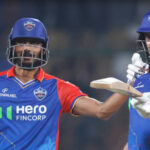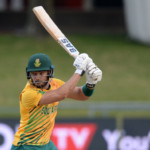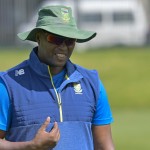Brian McMillan only started his international career in his late 20s, but he made a huge impact in a short space of time, which saw him rated as the world’s No 1 all-rounder and slip catcher in the mid-1990s, writes Alasdair Fraser.
Perhaps it’s fitting that an enduring image of Big Mac is the one of him clean bowling and shattering the stumps of England’s Sir Ian Botham at the 1992 Cricket World Cup.
As a 12-year-old it was like hitting the jackpot. I watched countless old VHS cassette tapes of The Ashes and knew exactly who Botham was. My very own ‘Botham’ had been smashing it on the domestic scene during isolation for several seasons, but on cricket’s biggest stage he had arrived.
Whether it was a weekend or weekday night, Newlands would be packed for the famous Benson & Hedges Night Series matches. Big Mac was a big part of those contests under a hot summer’s night. He would often open the bowling and occupy the No 5 spot on the batting list for Western Province.
The fact that McMillan moved to the Cape after breaking into Transvaal’s ‘Mean Machine’ during the mid-1980s was applauded. Under another fierce competitor, his captain and cricketing legend, the late Clive Rice, McMillan showed he belonged in that Transvaal side – arguably the finest provincial outfit in the history of South African cricket.
It’s where that hardness, which was a hallmark of his play for the Proteas, was polished. Any Australian team would have picked him. His sledging was top shelf – sharp, witty and all backed up with a heavy ball. The way Big Mac ambled his way to the stumps before unleashing a cannonball was unerring. There was no athletic rhythm just sheer brute force and no sign of letting up.
The motion of events that took place, which fast-tracked South Africa’s readmittance to the international scene, could not have come at a better time for Big Mac. He had matured as a batsman and it would give the Proteas a valuable weapon in their arsenal as they navigated their merry way along a path of new experiences of sub-continent pitches and new teams that South Africa had never played before.
He was an integral member of that 1992 Cricket World Cup side that sailed into the unknown and went on to surprise the world with a semi-final against England, which would famously be decided by the rain. Big Mac was at the coal face during that exciting run chase. We all know what happened … it still hurts.
His ODI record spoke volumes and he was an integral member of a South African side that dominated the 50-over format throughout the 1990s, but it was in the Test arena that McMillan showed his true value as an all-rounder.
At a time when Botham, Kapil Dev, Imran Khan, and the legendary Malcolm Marshall had retired, McMillan’s performances with bat and ball saw him claim the No 1 spot – albeit for a short space of time as he approached retirement in 1998. He retired with a batting average just shy of 40, which isn’t bad for a strike bowler who had a knack of knocking over crucial wickets.
What made McMillan extra special, though, was that he was exceptional in all three key disciplines of the Test cricket, with the third being slip catching. Big Mac had huge hands that made a cricket ball look more like a squash ball. Edges often got swallowed up with ease.
McMillan took just 18 Tests to score 1 000 runs and take 50 wickets. Given the Proteas’ lack of international experience and still finding their feet in Test cricket, it is an impressive stat that does not give the full impact of what he brought to the team.
While Brian McMillan shunned the limelight, his legacy to South African cricket will always be his all-round genius and hardness that he brought to a rookie South African outfit.
But the role he played in ensuring that the likes of Shaun Pollock and Lance Klusenser, and his former WP teammate and a fresh-out-of-school Jacques Kallis, would emulate and go on to eclipse his all-rounder achievements – breaking multiple records along the way – was his most valuable contribution to SA cricket.
Disclaimer: Cricket Fanatics Magazine encourages freedom of speech and the expression of diverse views from fans. The views of this article published on cricketfanaticsmag.com are therefore the writer’s own and do not necessarily represent the views of the Cricket Fanatics Magazine team.
Photo: Cricket World Cup Twitter











